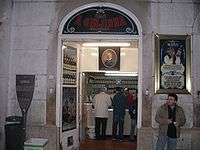Ginjinha

Ginjinha or simply Ginja, is a portuguese liqueur made by infusing ginja berries, (sour cherry) (Prunus cerasus austera, the Morello cherry) in alcohol (aguardente is used) and adding sugar together with other ingredients. Ginjinha is served in a shot form with a piece of the fruit in the bottom of the cup. It is a favourite liqueur of many Portuguese and a typical drink in Lisbon, Alcobaça and Óbidos. Other regions produce ginja with protected designation of origin, for example the Ginja Serra da Estrela.
History

The Ginjinha of the Praça de São Domingos in Lisbon was the first establishment in that city to commercialize the drink that gives its name to it. A Galician friar of the Church of Santo António, Francisco Espinheira, had the experience of leaving ginja berries in aguardente (the Portuguese brandy), adding sugar, water and cinnamon. The success was immediate and Ginginha became the typical drink of Lisbon. In the 2000s, the business was in the hands of the fifth generation. Currently, "the Ginjinha" is an exporter for the market in the United States. The production of Ginjinha reached over 150 thousand litres per year. In many places of Portugal, especially in the Lisbon and Oeste regions, there are several producers of this traditional liqueur. In Óbidos, Ginjinha is commonly served in a small edible chocolate cup.
Ginja de Óbidos e Alcobaça
The Ginja de Óbidos e Alcobaça, the fruit produced Alcobaça and Óbidos area, in Portugal, has applied for a PGI status in 2013.[1]
See also
References
- ↑ Ginja de Óbidos e Alcobaça in the DOOR database of the European Union. Retrieved 2014-03-16.
External links
- Ginja de Alcobaçawww.ginja.pt
- www.ginjadeobidos.com